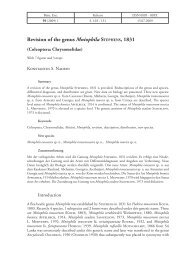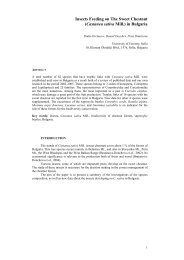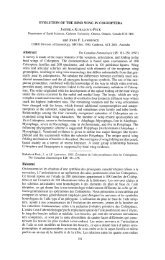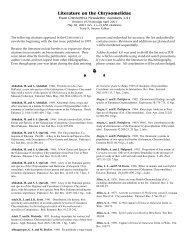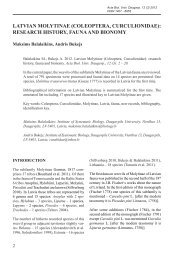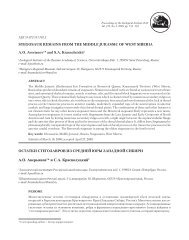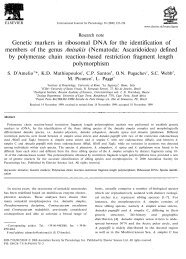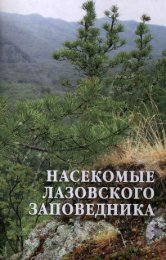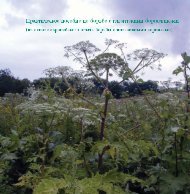International Meeting on Biology and Systematics of Staphylinidae
International Meeting on Biology and Systematics of Staphylinidae
International Meeting on Biology and Systematics of Staphylinidae
You also want an ePaper? Increase the reach of your titles
YUMPU automatically turns print PDFs into web optimized ePapers that Google loves.
22nd <str<strong>on</strong>g>Internati<strong>on</strong>al</str<strong>on</strong>g> <str<strong>on</strong>g>Meeting</str<strong>on</strong>g> <strong>on</strong> <strong>Biology</strong> <strong>and</strong> <strong>Systematics</strong> <strong>of</strong> <strong>Staphylinidae</strong> 2007 – abstracts<br />
A review <strong>of</strong> Nearctic leptotyphlines (Coleoptera: <strong>Staphylinidae</strong>: Leptotyphlinae).<br />
Using ecological niche modeling to predict geographical distributi<strong>on</strong>s <strong>of</strong><br />
leptotyphlines in America north <strong>of</strong> Mexico<br />
VLADIMIR GUSAROV<br />
Nati<strong>on</strong>al Centre for Biosystematics, Natural History Museum, University <strong>of</strong> Oslo,<br />
P.O. Box 1172 Blindern, NO-0318 Oslo, Norway<br />
e-mail: vladimir.gusarov@nhm.uio.no<br />
Geographical distributi<strong>on</strong> <strong>of</strong> leptotyphlines, both worldwide <strong>and</strong> in North America, is<br />
reviewed. Collecting methods are discussed, with particular reference to soil flotati<strong>on</strong>. An<br />
introducti<strong>on</strong> to ecological niche modeling <strong>and</strong> its use for predicting <strong>of</strong> geographical distributi<strong>on</strong><br />
is presented. The approach is extended to predict distributi<strong>on</strong> <strong>of</strong> supraspecific taxa including<br />
multiple species, similar ecologically. Using Desktop GARP, a model predicting distributi<strong>on</strong><br />
<strong>of</strong> leptotyphlines in North America is developed.<br />
The genera Lispinus <strong>and</strong> Tannea (Osoriinae) in Costa Rica<br />
– Ecological <strong>and</strong> Zoogeographical remarks –<br />
ULRICH IRMLER<br />
University Ecology-Centre, Olshausenstrasse 40, 24098 Kiel, Germany<br />
e-mail: uirmler@ecology.uni-kiel.de<br />
The informati<strong>on</strong> labelled <strong>on</strong> Lispinus <strong>and</strong> Tannea specimens from Costa Rica deposited<br />
in several museums is exploited c<strong>on</strong>cerning the collecting locality <strong>and</strong> ecological remarks. In<br />
total, 15 species <strong>of</strong> each genus with 458 specimens <strong>of</strong> Lispinus <strong>and</strong> 817 specimens <strong>of</strong> Tannea<br />
have been available for the study.<br />
Whereas Lispinus was mainly recorded from the under bark habitat, Tannea was found<br />
in the forest litter. The species <strong>of</strong> the two genera seem to differ also in their feeding habit.<br />
Intestines <strong>of</strong> both Lispinus <strong>and</strong> Tannea c<strong>on</strong>tained mainly fungus <strong>and</strong> arthropod remnants respectively.<br />
Altitude distributi<strong>on</strong> results in 4 species occurring over the whole gradient <strong>and</strong> 15<br />
species restricted to special life z<strong>on</strong>es in the altitude gradient. Two species are <strong>on</strong>ly known<br />
from an elevati<strong>on</strong> higher than 2000 m. One species shows an adaptati<strong>on</strong> to the high altitude<br />
habitat by reducti<strong>on</strong> <strong>of</strong> hind wings.<br />
Seven species seem to be endemic in Costa Rica reflecting elements <strong>of</strong> the Talamanca-<br />
Chiriqui regi<strong>on</strong>. Two species represent the Central American fauna, 6 species a Central-<br />
America – Andean distributi<strong>on</strong>, 8 species a Central-American – Circum Amaz<strong>on</strong>ian distributi<strong>on</strong>,<br />
<strong>and</strong> 4 species a Pan-Neotropical distributi<strong>on</strong>. Furthermore, the central mountain range<br />
separates some species with a more western or more eastern distributi<strong>on</strong>, which might referred<br />
to wetter or drier c<strong>on</strong>diti<strong>on</strong>s <strong>of</strong> the mountain slopes.<br />
__________________________________________________________________________________________<br />
Staatliches Museum für Naturkunde Stuttgart 11




